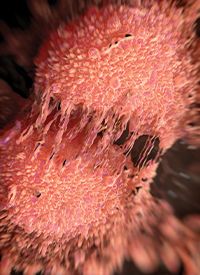Article
Darolutamide Improves Survival in Nonmetastatic CRPC
Author(s):
Darolutamide plus androgen deprivation therapy (ADT) led to a significant improvement in overall survival (OS) compared with placebo and ADT in patients with nonmetastatic castration-resistant prostate cancer, according to results from a preplanned final OS analysis of the phase III ARAMIS trial.
Prostate Cancer

Darolutamide (Nubeqa) plus androgen deprivation therapy (ADT) led to a significant improvement in overall survival (OS) compared with placebo and ADT in patients with nonmetastatic castration-resistant prostate cancer (CRPC), according to results from a preplanned final OS analysis of the phase III ARAMIS trial.1
Previously, the study showed that the darolutamide regimen showed a statistically significant improvement in metastasis-free survival (MFS), which was the primary efficacy endpoint of ARAMIS.2,3 The median MFS was 40.4 months with darolutamide/ADT and 18.4 months with placebo/ADT, leading to a 59% reduction in the risk of metastases or death (HR, 0.41; 95% CI, 0.34-0.50; P <.0001). Based on these primary findings, the FDA approved darolutamide in July 2019 for the treatment of patients with nonmetastatic CRPC.
Full results from the final analysis, which will include data on additional endpoints and a long-term safety update, will be presented at an upcoming medical meeting, according to a statement by Bayer, which jointly develops darolutamide with Orion Corporation.
In the double-blind, placebo-controlled, multicenter, phase III ARAMIS study, investigators evaluated the efficacy and safety of darolutamide in combination with ADT in 1509 patients with nonmetastatic CRPC who were receiving a concomitant gonadotropin-releasing hormone analog or had a bilateral orchiectomy. Patients were randomized 2:1 to receive 600 mg of oral darolutamide twice daily or placebo plus ADT.
All patients had an ECOG performance status of 0 to 1. The primary endpoint was MFS, and key secondary endpoints were OS, time to pain progression, time to initiation of first cytotoxic chemotherapy, time to first symptomatic skeletal event, and characterization of the safety and tolerability.
At the time of the final MFS analysis, OS data were immature, but data also showed a trend toward improved survival. The 3-year rates of OS were 83% in the darolutamide arm versus 73% with placebo, translating to a 29% reduction in the risk of death (HR, 0.71; 95% CI, 0.50-0.99, P = .0452), according to results of an interim OS analysis.
Additional ARAMIS findings showed that darolutamide also maintained quality of life and led to a 35% reduction in the risk of pain progression versus placebo in this patient population (HR, 0.65; 95% CI, 0.53-0.79; P <.0001).4 The AR inhibitor also led to a 57% reduction in the risk of symptomatic skeletal event development compared with placebo (HR, 0.43; 95% CI, 0.22-0.84; P = .011).
Regarding safety, adverse events (AEs) that occurred more frequently with the androgen receptor inhibitor versus placebo were fatigue (16% vs 11%), pain in extremity (6% vs 3%) and rash (3% vs 1%).
Moreover, data presented at the 2019 ESMO Asia Congress from the ARAMIS trial also showed that darolutamide delays disease progression and subsequent treatment for patients with nonmetastatic CRPC compared with placebo, while maintaining quality of life.5
The international, double-blind, placebo-controlled, phase III ARASENS study is exploring darolutamide plus ADT in combination with docetaxel in approximately 1300 patients with newly diagnosed, metastatic hormone-sensitive prostate cancer (NCT02799602).
References
- Nubeqa (darolutamide) plus androgen deprivation therapy achieved the secondary endpoint of overall survival (OS) in men with non-metastatic castration-resistant prostate cancer [news release]: Whippany, NJ. Bayer. Published January 30, 2020. https://bit.ly/3aTXBAD. Accessed January 30, 2020.
- Fizazi K, Shore N, Tammela TL, et al. Darolutamide in nonmetastatic, castration-resistant prostate cancer. N Eng J Med. 2019;380(13):1235-1246. doi: 10.1056/NEJMoa1815671.
- Fizazi K, Shore ND, Tammela T, et al. ARAMIS: efficacy and safety of darolutamide in nonmetastatic castration-resistant prostate cancer (nmCRPC). J Clin Oncol. 2019;37(suppl 7s; abstr 140). doi: 10.1200/JCO.2019.37.7_suppl.140.
- Fizazi K, Shore ND Tammela T, et al. Impact of darolutamide (DARO) on pain and quality of life (QoL) in patients (Pts) with nonmetastatic castrate-resistant prostate cancer (nmCRPC). J Clin Oncol. 2019;37(suppl 15; abstr 5000). doi: 10.1200/JCO.2019.37.15_suppl.5000.
- Pang J S-T, Shore N, Smith MR, et al. Efficacy and safety of darolutamide in non-metastatic castration-resistant prostate cancer (nmCRPC) in the ARAMIS trial. Ann Oncol. 2019;30(suppl_9):mdz424.001. doi: 10.1093/annonc/mdz424.001.









